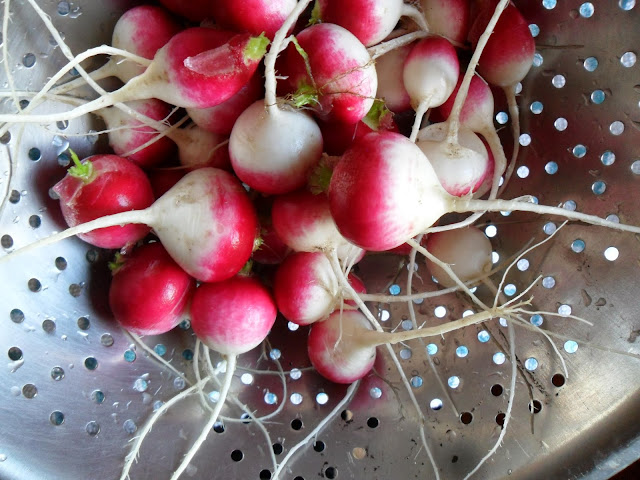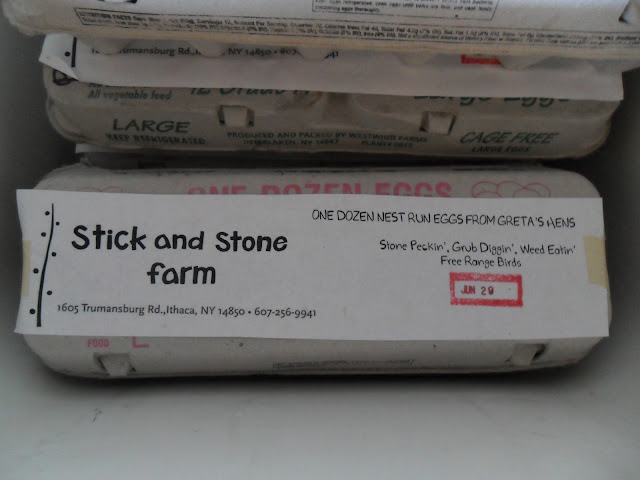There’s
no denying it. Food is so hot right now. Especially if it’s local,
organic, and held proudly by a small child with rosy cheeks. This is
good. Food is important. The revival of interest in real food and where
it comes from is reflected in the snack gardens in schools filled with
sugarsnap peas and lettuces, the popularity of backyard gardening, and
living walls adding life to hi-rises. Please, let it be noted that I am a
yea-sayer to all this activity.
But...well...sometimes,
there is something important missing in this whole scene. And that’s
urban farming. And I don’t just mean some school kids growing 50kg of
potatoes, or you tending some herbs on your balcony -- though both
things make me happy. I mean production gardens. Small farms and
regular-sized farmers who grow good amounts of food to feed
neighborhoods. This is a scale and an element of our food system which
needs talking about, needs valuing, and needs to be realised.
When
this is mentioned, there is often a respectful muttering of “cuba” and
“self-sufficiency”. Yep, Cubans grow a helluva lot of food in their
cities. Millions of tonnes per year. And they make an enviable amount
of compost. Yes, they had to. Yes, they were embargoed. Yet this is often where the daydreaming ends. And we head off to
buy some lettuce that travelled a few hundred kms by supermarket truck
to have the privilege of being in our salad. Maybe, we wonder, the sort
of city-based, well-orchestrated food system that Cuba boasts only
materialises when people are starving and when there is an autocratic
government to organise people into teams and land into gardens? Well,
not necessarily. There’s an alternative plotline.
First,
we need to start imagining our city bursting with food; good,
plentiful, delicious abundance. A city dotted with farms started by
enterprising, hardworking farmers dedicated to growing a lettuce which
doesn’t get carsick on the way to the store. A lettuce that you pick up
along with your weekly share of produce which is carried home on your
bike, in your backpack. You get the point: it’s grown near where you
live. This imagining takes some work. Sometimes it’s hard to see the
food forest for all the uncompromising asphalt. City farms might not
look like little scenes of bucolic loveliness nestled into a hillside,
surrounded by pasture and doe-eyed cows. But they will be beautiful all
the same, as integrated systems that combine age-old-know-how with
cutting edge technology. Food systems that take inspiration from
farmers all over the world. We have the internet and we will use it
wisely. And these systems will just keep getting more elegant. People
will stop measuring their food in miles and start walking and riding to
their local farm, whistling cheerfully, the wind in their hair, the sun
on their backs... Ok, I’ll stop now.
Seriously, these farms will not only provide gold-standard food for
your mouths. They will create livelihoods for the farmers and others who
make it all happen. Farming, especially on a small scale where your
body is your tractor, is hard work. Days can be long, wet, hot, and
exhausting. Days can also be gorgeous, warm, and filled with satisfying
labour, good conversation, and bird calls. Either way, you don’t want to
fit a farm enterprise around a full-time off-farm job, not when you
have a few hundred mouths to feed. It needs to provide you with a
livelihood.
I
used to manage a community garden. Every day held new discoveries,
learning and connections. The focus was on engaging kids and adults with
the soil, with living plants, with cooking something grown from seed
and serving it proudly to the community. That community garden remains
as much a playground of ideas as anything. A place of focus where people
can contribute, can argue, try new things, test something out, make
mistakes, eat, get distracted, meet someone new, learn something, forget
what they learned and just a place to hang around in. Especially if you
don't really have anywhere else to go. And while we would load up a
harvest table with whatever was ready (always plenty of silverbeet),
this was not a production garden for many reasons - it’s size, it’s
organisation, it’s volunteer base, and most importantly because of the
aim of the garden. This was not a garden to feed people.
It
seems obvious when it’s spelled out like that. But too often the
excitement (duly felt) about community gardens, pop-up mall vege patches
and guerilla gardening can get in the way of thinking about what
systems could, would fill our larders with enough to eat each week. And
an urban farm is probably not going to pump out the food if the farm is
relying on volunteer labour alone. “But what about the whole good-vibes
community thing?”, you ask (perhaps more eloquently).
A
farm is a community resource. Local businesses likewise. Organisations
that provide a service to the people - a useful place, a place where
people meet, things to be utilised. A place that provides livelihoods
and lively neighborhoods. We do have examples here in Australia… just
not enough of them.
While
visiting farms in the states I spent a couple of days at Sweet Land
Farm, a CSA farm in Trumansberg, upstate New York, that feeds 350
families in their community. This is a farm started by a couple as a
business. A business with solid ethics and an actual, written-down, list
of what they are not willing to compromise, in terms of values, in
their business. They employ people who learn and practice skills in crop
planning, transplanting, harvesting, and produce handling. Men and
women who often end up starting their own small farms. I was already
impressed. But more so when it came to be CSA share pick-up day. As
people rolled in, some with kids in tow (who quickly made for the U-pick
strawberry patch) to collect their food for the week, I saw community. I
saw people connect who met through their connection to this farm,
swapping news, recipes, and smalltalk. I saw people making a tangible
connection with their food choices. They can actually touch the farm
(and the farmer, if they are feeling cheeky). They can pick their share
of peas, and their share of blue cornflowers. They can ask the farmers
about squash varieties and their plans for the future seasons. They see
what food production is about. The work. The dirt. The sweat. The
people.
"Farmers
need a place to farm and make a viable living. Farmland needs to be
enriched and nurtured so that it can yield bountiful harvests year after
year. Members need a dependable source of vibrant, richly grown food.
All of these needs must be kept in balance. Sweet Land Farm is a
CSA-only farm, so everything that we grow is for you, the shareholders.
This makes the above-mentioned balance nicely transparent"
(Sweet Land Farm member handbook)
It’s
a business and a community resource. Sure, Sweet Land Farm is a pretty
big farm, sitting on the outskirts of a pretty small town; but the same
connection of people to place, to community, to food can happen right
here in our cities, in our suburbs. People are pretty good at getting
innovative and working with smaller areas. They grow stuff on rooftops,
in laneways, in vacant quarter acre lots, laid out like mini farms -
with wheel-hoes instead of tractors. In fact, having less space forces
people to be more creative, more innovative in growing food. There are a
lot of brains working on this puzzle already.
Urban
farming is not the answer to the big question of how to feed ourselves,
dare I say it, sustainably. It’s just a really useful, and
underutilised part of the food system. And there will be crops that will
be grown on farms outside cities - grains and seed crops that make more
sense on a larger scale. But perishable vegetables, those that are at
their snap-juicing-sweetest heights when they travel only a metre from
plant to mouth should be grown as close to that mouth as possible. Have
you ever grown strawberries? Snow peas? Radishes? Try it (taste it) and
prove me wrong.
So
where to from here? For starters let’s start valuing farmers and
farm-work. I mean individually, and as a city. In the last year, in Hobart, someone
got around $27,000 in subsidies for an artificial ice skating rink business (that’s
about to be superseded a year down the track). Now I like ice skating as
much as the next guy (though I prefer glistening, real ice) but I care a
lot more about what’s for dinner. How about support for enterprising
farmers, who want to grow good food for their community? And, yes, earn a
livelihood in doing so. I’m ok with my money going to that corner.
We
need farmers and we need them to be able to sustain themselves and
their families. We need new farmers. We need farming to be an attractive
prospect to young people thinking ‘what do I want to be when I grow
up?’. We have the means, we have the ways, we all just need to get on
board with this. We, local and state government staff (including town planners and policy makers), home gardeners, small-hold farmers, community/school
gardeners, agricultural scientists, and eaters of food. That pretty much covers everyone,
right?
Let’s
not just wait patiently for our supply of food from the mainland to get
held up indefinitely, for the moment when you find shelves empty and
produce aisles lacking. Let’s not wait for an embargo, a disaster.
That’s no time to get organised, to innovate (though invariably it will
happen then too). Now is the time. It’s not simply food for thought,
it’s food forethought.
-------------------------------------------------------------------------
Post-script: Nov 2015. It's happening!!! Go to www.hobartcityfarm.com or www.chuffed.org/project/hobartcityfarm to find out more about a city farm in Hobart, Tasmania, Australia.
--------------------------------------------------------------------------------------------------------------------------------------------------------















































